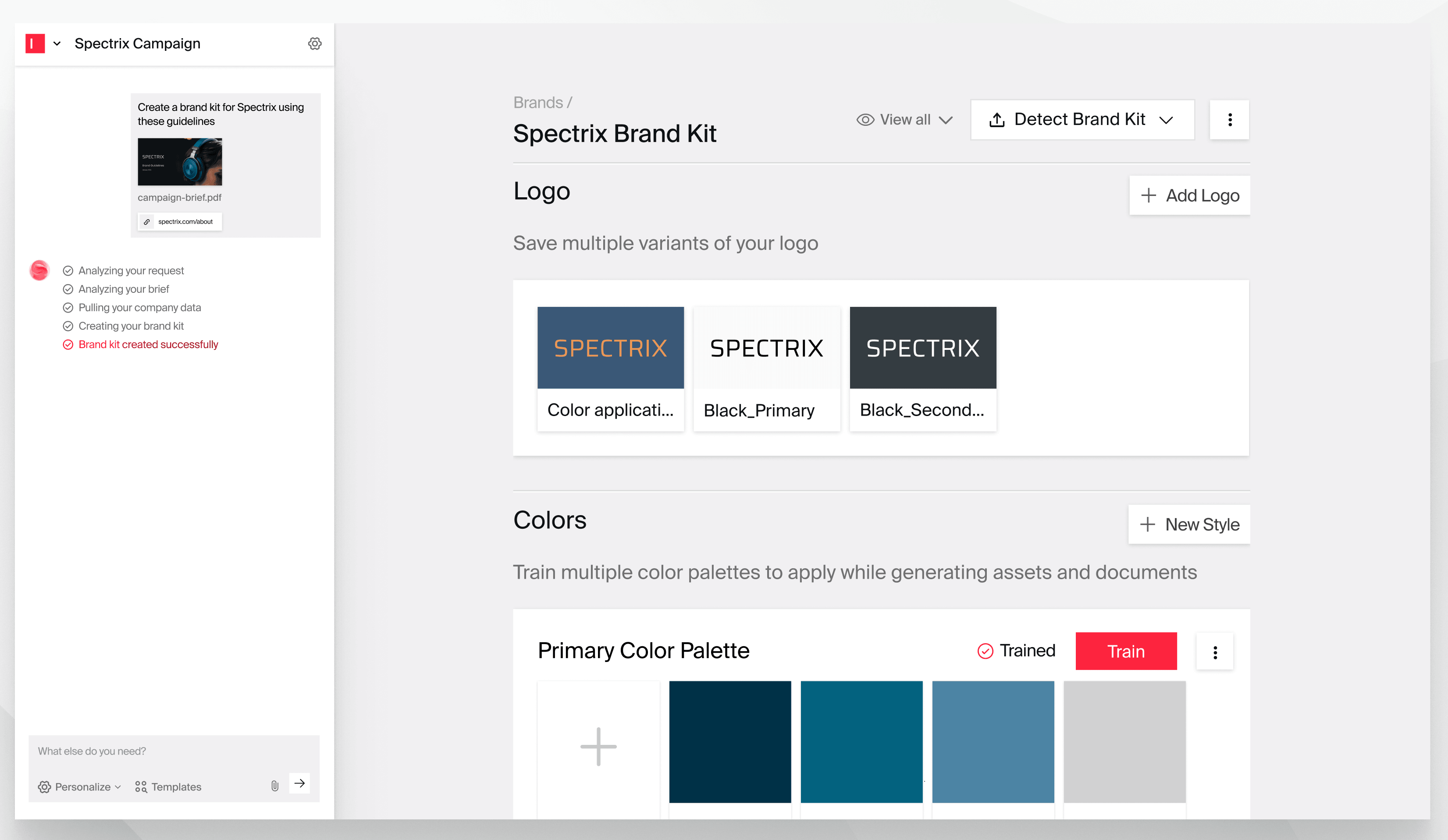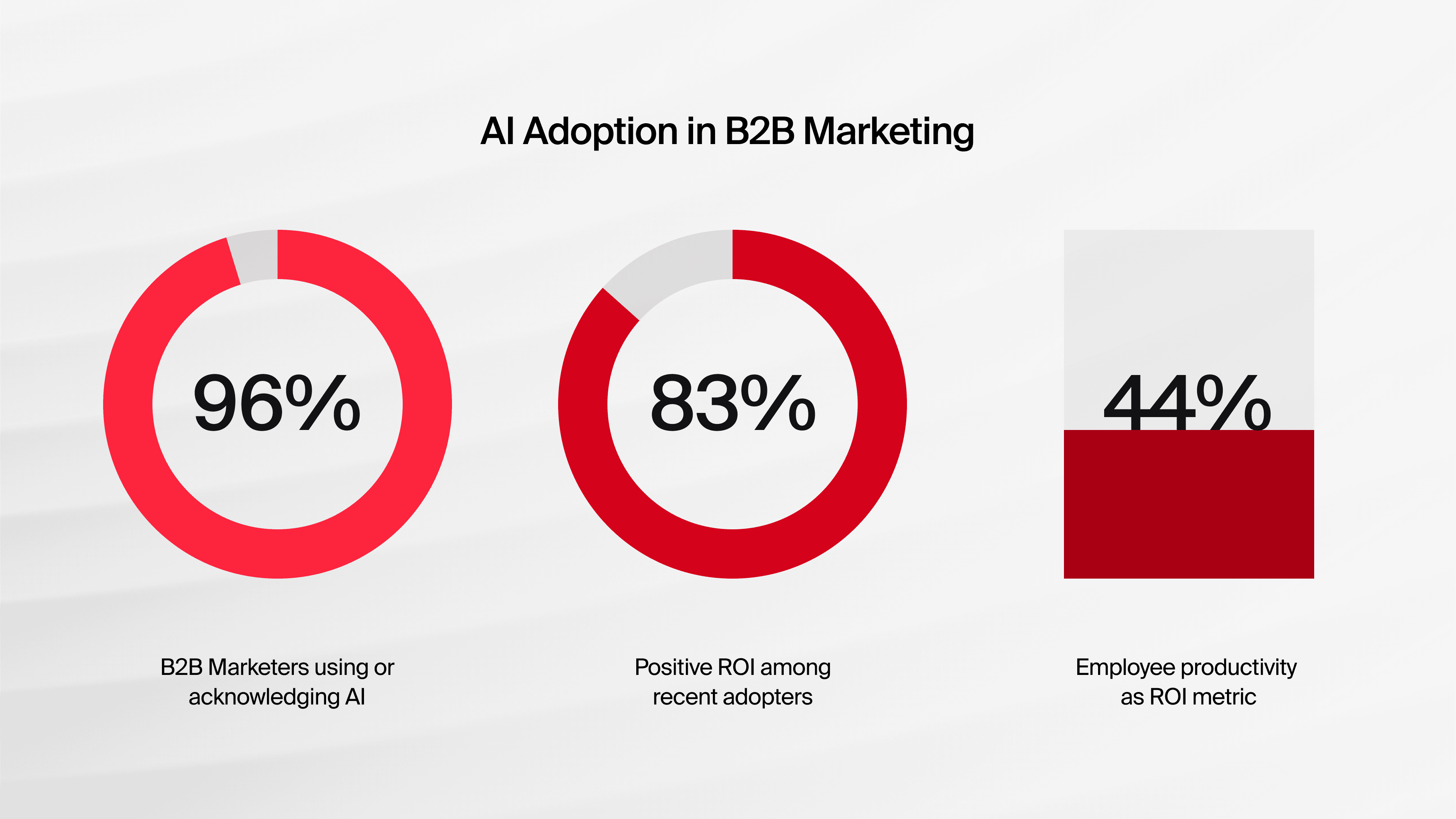AI at Work
Engaging the Enterprise in 2025: Top B2B Strategies Creating Competitive Advantage

Ashwini Pai · Senior Copywriter
April 21st, 2025 · 14 min read

The B2B marketing landscape has undergone a fundamental transformation, rendering traditional approaches increasingly ineffective for generating meaningful growth and competitive advantage. Today's CMOs face the critical challenge of leveraging sophisticated marketing technologies to engage well-informed buyers throughout increasingly complex purchasing journeys. As marketing leaders navigate this evolving terrain, generative AI has emerged as the standout technology with the potential to create sustainable differentiation.
Key takeaways
Enhancing email personalization: New email regulations from Google and Yahoo demand deeper personalization across scale to ensure meaningful interactions and boost deliverability.
Unlocking the full potential of your CDP with AI: Despite widespread CDP adoption, only 17% of companies achieve high utilization. AI bridges this gap, activating customer data for personalized, multichannel engagement.
Leading with differentiation: In a crowded B2B market, consistent, impactful messaging sets brands apart. Ensuring on-brand content across all touchpoints builds trust and confidence.
Refresh, repurpose, rank: With AI chatbots shifting search behavior, brands need fresh, authoritative content to stay visible. AI streamlines SEO refreshes and repurposing, aligning with conversational AI models to enhance discoverability.
AI workflows create bandwidth for high-value work: AI workflows automate tedious tasks, boosting content creation efficiency and giving marketers more time to focus on strategy and creativity.
Agentic AI is the future of marketing automation: AI agents transform marketing by autonomously making decisions, optimizing campaigns, and adapting content in real-time.

1. Changing deliverability driving email personalization
Last year, Google and Yahoo introduced email regulations targeting non-compliant bulk email practices with the aim to reduce spam, increase security, and improve the user experience. As the personalized ads in ‘Promotions’ and ‘Social’ tabs of Gmail inboxes contribute to Google’s ad revenue, the new rules also help protect the service’s reputation and user base.
According to Google, bulk senders are those who dispatch more than 5,000 messages to Gmail addresses in one day. Companies that fail to meet the sender requirements will get temporary errors and face higher rejection rates. This is playing out already, with a study finding that the spam complaint rates across B2B marketing teams are far exceeding the 0.3% threshold set by Google and Yahoo.
The new rules can be managed by giving potential clients a good reason to engage with your brand. Practically, this means account-based marketing personalization must go beyond addressing clients by name and including their company logo in emails to create content that considers their unique challenges, attributes, and preferences.
Another recommended tactic is a multichannel approach to ABM — running display and social media ads alongside email. This helps marketers gain a clearer view of customer interactions and behaviors and understand how these influence decisions around channels and tactics.
What this means for you
Whether you send thousands or far fewer emails in a day, making every contact count with a highly personalized approach is key to boosting deliverability, engagement, and response. To increase customer interactions with high-impact email campaigns:
Ensure compliant, on-brand emails: Use Typeface’s Brand Agent to automatically verify messaging against your guidelines, suggest improvements, and maintain consistency and recognizability across regions.
Generate email journeys: Leverage Typeface’s Email Agent to generate personalized emails tailored for each audience and stage of the journey. Import your own email templates for consistent visual branding.
Collaborate seamlessly: Use built-in content workflows to monitor team and agent progress, getting notifications for reviews and approvals in one place.
Optimize continuously: Optimize content based on analytics and user feedback to improve email engagement with your target accounts.
2. Leveraging AI to maximize value from CDP investments
The growing use of customer data platforms in organizations of all sizes is evident with 72% of marketers worldwide having invested in CDPs and usage set to increase. While one set of data suggests that organizations are putting their trust in CDPs to boost personalization, engagement, and business performance, recent Gartner research paints an eye-opening picture of actual CDP use — a mere 17% of organizations report “high utilization” of their CDP and falling short of driving the desired value from their technology investment.

AI bridges the gap between the valuable data in CDPs and its activation in a number of ways, enabling organizations to extract the platform’s potential and drive better results from content. By connecting your CDP with generative AI marketing platforms like Typeface, you can turn underutilized data into meaningful, real-time content.
Our AI can analyze vast amounts of CDP data faster and easier than manual segmentation to understand which content types resonate with which audience. It can then tailor ad copy, blogs, emails, social media posts, and imagery to different personas. By automatically adjusting tone, voice, and messaging based on your audience segments, it can then activate your CDP data with personalized content.
What this means for you
To transform your CDP from an underutilized data repository into a strategic marketing asset:
Connect your data ecosystem to your content ecosystem: Integrate your CDP with Typeface's AI Brand Hub to create a seamless flow of customer insights directly into your content creation process. Set up audience profiles within Typeface that mirror your CDP segments, ensuring content is automatically tailored to specific buyer personas and account characteristics.
Create segment-specific content at scale: Leverage your rich CDP data to inform truly differentiated messaging for various buyer types. Use Typeface’s Email Agent and Ad Agent to generate variations tailored to your audience segments.
Implement multichannel content coordination: Ensure your multichannel campaigns deliver consistent yet channel-optimized experiences. Use our platform to activate targeted campaigns across email, social media, and web with content optimized for each channel.
Build continuous optimization loops: Generate and test different creatives, messaging, and formats to swiftly deploy high-performing assets for various audience segments.

3. Leading through brand differentiation
Gartner research identified the strategies that the most successful CMOs in 2025 will implement. Among these is differentiating the value of products in the marketplace.
In B2B buying, decisions are rational rather than emotional and the big picture of product and use cases matters more than specific features. As is often seen, successful product features are often adopted by competing companies, making differentiation more challenging. If a keen understanding of the target audience and a strong value proposition are essential, effective, and consistent messaging at all touchpoints and in all brand content is crucial to reinforce the product’s promise.
Ensuring that every interaction reflects your brand’s position on products and speaks with one voice is easier said than done. Marketing teams are known to spend significant time on reworking assets that either don’t align with the latest product features and positioning or new brand content guidelines. In contrast, leaders in brand differentiation aren’t only succeeding at being different but telling clear and authentic brand stories across touchpoints and continually adapting to evolving customer expectations, market shifts, and competitor threats without losing their core identity.
What this means for you
To rise above the noise with content that delivers real differentiation:
Develop a strategic brand framework: Create a comprehensive brand strategy that goes beyond visual identity to articulate your unique perspective on industry challenges. Use Typeface's Brand Hub to establish a dynamic, evolving brand intelligence system that adapts to market shifts while maintaining your core differentiation.
Enable consistent storytelling across teams: Rather than policing brand compliance, empower teams with tools that make it easy to stay on-brand. Deploy Brand Agent to automatically validate content against guidelines, recommend improvements, and ensure every touchpoint reinforces your differentiated position.
Transform technical capabilities into customer value stories: Move beyond feature comparisons by focusing on the unique outcomes you enable. Leverage Creative Agent and Video Agent to produce multimodal content that brings these value stories to life through compelling visuals and narratives.
Create differentiation through personalized experiences: Use your customer data to deliver tailored content experiences that demonstrate deep understanding of specific industry challenges. Apply Typeface's personalization capabilities to create account-specific messaging that speaks directly to each prospect's unique situation.
Establish thought leadership that shapes industry perspective: Rather than following conversations, lead them. Develop a distinctive point of view on industry evolution and use Typeface to efficiently create a consistent stream of thought leadership content that positions your brand as a forward-thinking guide rather than just another vendor.

4. Boosting SEO through strategic content refreshes and fresh content
Last year, leaked Google documents revealed secrets of search ranking algorithms. One of the findings related to how Google evaluates content freshness, an important aspect of SEO. To determine the recency of content, Google looks at dates in the byline, URL, and on-page content. This revelation is no small matter and has brought the importance of regularly updating brand content into sharper focus.
Another significant development is the inevitable increase in conversation-based search thanks to the growing adoption of AI chatbots. It portends an end to link-based search, forcing brands to rethink their content strategy.
Content is the foundation on which brand positioning takes seed and grows stronger. Building your site up to be an authoritative resource and a decision-making tool is a natural and essential process. Creating quality SEO content is a continuous effort but even though B2B marketers would like to scale brand content, only one in three have a scalable model to do so.
With fresh, authoritative, and conversational content being vital for visibility in AI-driven search environments, brands must start aligning strategy with conversational AI models to remain discoverable.
What this means for you
To inject SEO efforts with freshness, authority, and conversational relevance:
Implement a strategic content refresh program: Develop a systematic approach to content refreshes based on performance data Use Typeface's intelligent AI to identify high-potential pages, then enhance them with updated statistics, emerging keywords, and new insights — satisfying Google’s freshness metric without starting from scratch.
Balance global consistency with local relevance: Extend your SEO impact by creating market-specific content variations that maintain core brand positioning while addressing regional search behaviors. Generate geo-targeted blog posts to boost local search performance as you carve your presence in new and emerging markets.
Blend automation and strategy to adapt faster to conversational search: Harness Arc Agents to automate repetitive tasks in the content creation process and empower your team to plan strategic, engaging content and design that help gain traffic from conversational search. Establish scalable workflows that increase content production speed while maintaining quality, enabling your brand to rapidly respond to emerging search trends and algorithm changes.
5. Greater adoption of AI workflows to save time for higher-value tasks
A recent survey revealed that 96% of B2B marketers are either already leveraging AI or recognize its potential impact with majority of teams prioritizing the technology to improve productivity and enhance customer engagement. And for many, that investment is already paying off—among those whose organizations adopted an AI platform in the past three months, 83% have already seen a positive return on investment. Notably, employee productivity emerged as the top metric for gauging that ROI cited by 44% of respondents.

AI’s value lies in freeing marketers’ time so they can tap their insights and creativity to ideate premium content, build adaptive content strategies, and find opportunities in future challenges. Leveraging AI to automate repetitive tasks within workflows enhances efficiency, accuracy, and productivity. With AI workflows taking care of tedious manual tasks, teams are free to focus on higher-order activities with the potential to generate impact and effect meaningful change.
What this means for you
To let automation handle the busywork so you can focus on what truly matters:
Implement AI throughout your marketing stack: Streamline the entire content lifecycle with AI workflows that provide clear visibility into each stage, from creation through review to final approval.
Retain your creative flow: Build multiple workflows for different types of content while preserving your familiar ways of working—now with greater efficiency, visibility, and accountability.
Make collaboration even more seamless: Enable real-time engagement and fast decision-making with automatic notifications delivered directly to team members' inboxes and Slack channels.
6. Agentic AI set to transform marketing automation
For enterprise marketers, the value of generative AI lies in generating brand content at scale in lesser time and with fewer resources. What if marketing teams could delegate decision-making to AI, intervening only minimally? Agentic AI represents the next evolution of enterprise AI and has the potential to transform marketing as we know it.
AI agents use the reasoning capabilities of LLMs to autonomously make decisions, take actions, and learn from user behavior, improving over time.
Imagine a team of AI agents that create customer profiles, conduct A/B testing for messaging and design, and dynamically adapt content based on real-time customer data. A sophisticated agentic AI platform doesn’t just automate tasks — it strategizes, optimizes, and orchestrates complex marketing workflows using available tools to maximize engagement and conversions.
Although these are capabilities to look forward to, most current agentic AI solutions are still in their early stages and require pre-set rules or human oversight. The recommended approach is to start with agents that elevate everyday workflows and scale to a future of limitless possibilities.
What this means for you
Paving the way for future agentic AI takes vision and bold action. Here’s how you can lay the groundwork:
Unite automation and creativity: With Arc Agents working alongside your team, you can gain massive efficiencies and take creativity, strategy, and experimentation to the next level.
Get familiar with AI agents that excel in specific content domains: These Channel Specialists provide domain-specific excellence. Ideation Agent generates campaign concepts, Ad Agent optimizes creatives across platforms, Web Agent creates SEO-optimized content using competitor and keyword data.
Create and deploy custom agents: Leverage the opportunity to create no-code AI agents to handle your specific needs, training them on your processes to deliver intelligent, consistent support.
Turn content into a growth engine
The B2B marketing landscape has fundamentally shifted—from email deliverability challenges requiring deeper personalization to maximizing CDP investments, maintaining brand differentiation, and optimizing content for emerging search patterns. Success will hinge on embracing AI not merely as a tool but as a strategic partner.
It begins with implementing AI workflows that automate routine tasks so that marketers can redirect their talents toward strategic innovation and creative excellence. This apart, working with AI to deliver hyper-personalized experiences will be a game-changer, unlocking the true potential of customer data, driving strategic decision-making, and enabling marketers to achieve levels of precision, efficiency, and impact that were previously unimaginable.
With Typeface’s powerful AI capabilities, B2B marketers can lead the way, delivering impactful results now and in the future. Contact sales to learn more or get a demo right away.

Share
Related articles

AI at Work
AI Personalization in Marketing - Creating Tailored Content for Diverse Audiences

Neelam Goswami · Content Marketing Associate
November 28th, 2024 · 11 min read